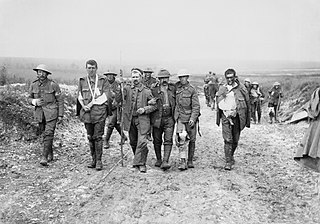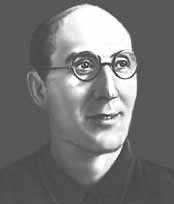
The total number of military and civilian casualties in World War I was about 40 million: estimates range from around 15 to 22 million deaths and about 23 million wounded military personnel, ranking it among the deadliest conflicts in human history.

The Battle of the Somme, also known as the Somme offensive, was a battle of the First World War fought by the armies of the British Empire and the French Third Republic against the German Empire. It took place between 1 July and 18 November 1916 on both sides of the upper reaches of the river Somme in France. The battle was intended to hasten a victory for the Allies. More than three million men fought in the battle, of whom one million were either wounded or killed, making it one of the deadliest battles in all of human history.

Execution by firing squad, in the past sometimes called fusillading, is a method of capital punishment, particularly common in the military and in times of war. Some reasons for its use are that firearms are usually readily available and a gunshot to a vital organ, such as the brain or heart, most often will kill relatively quickly.

Edward Richard Holmes, CBE, TD, JP, VR, known as Richard Holmes, was a British military historian. He was co-director of Cranfield University's Security and Resilience Group from 1989 to 2009 and became Professor of Military and Security Studies at Cranfield in 1995.

The Allies, or the Entente powers, were an international military coalition of countries led by the French Third Republic, the United Kingdom of Great Britain and Ireland, the Russian Empire, the United States, the Kingdom of Italy, and the Empire of Japan against the Central Powers of the German Empire, the Austro-Hungarian Empire, the Ottoman Empire, and the Kingdom of Bulgaria during the First World War (1914–1918).

Sergei Mikhailovich Tretyakov was a Soviet Russian constructivist writer, playwright, poet, and special correspondent for Pravda.

The Monocled Mutineer is a 1986 BBC television drama series starring Paul McGann about the Étaples mutiny in 1917 during the First World War. The four-part serial, which was the first historical screenplay written by Alan Bleasdale, dramatised the life of British Army deserter Percy Toplis. It was adapted from the 1978 book of the same name by William Allison and John Fairley.
Private Thomas James Highgate was a British soldier during the First World War and the first British soldier to be convicted of desertion and executed by firing squad on the Western Front. He was born in Shoreham and worked as a farm labourer before joining the army in 1913 as a seaman. When the First World War began, he fought with the First Battalion of the Royal West Kents. Highgate was executed 35 days into the war, on 8 September 1914, after being found hiding in a farmhouse wearing civilian clothes. His death was made as public as possible and used as an example to other soldiers. Highgate's name was not included on the war memorial at Shoreham; from the late 1990s onwards, some local residents fought for his name to be added whilst others disagreed. Posthumous pardons for soldiers who had been executed, including Highgate, were announced in 2006.
Piet Chielens a Belgian writer, translator and curator. He is coordinator of the In Flanders Fields Museum in Ypres (Ieper) in Belgium. He is also artistic director of Vredesconcerten Passendale.
Julian Putkowski is a British university teacher, military historian, researcher, and broadcaster. He has written extensively on military executions in World War I.
Gerard ("Gerry") Oram is a notable British cultural and social historian, with a particular interest in the First World War. He was a researcher at the University of Birmingham and the University of Swansea, before going on to teach at the Open University. He lectures at Swansea University teaching on a number of modules including Nazi Occupied Europe and the First World War. Oram also lectured at Cardiff University where he taught the War, Liberation and Reconstruction: Europe 1939-51 module. His seminal book, Death Sentences passed by military courts of the British Army 1914–1924, is on the recommended reading lists of the National Archives and the Imperial War Museum.

Henry William Massingham was an English journalist, editor of The Nation from 1907 to 1923. In his time it was considered the leading British Radical weekly.
Wang Jungzhi was a Chinese labourer, who was one of the last people to be executed by the British Army during the First World War. He was convicted of murder and executed by firing squad on 8 May 1919, six months after the Armistice.
Guy Pedroncini (1924-2006) was a French academic and military historian specialising in the First World War, and notable as the biographer of Philippe Pétain and for his work on the French army mutinies of 1917. He was born in Paris on 17 May 1924 and died on 11 July 2006, at the age of 82.
Alan M. Kent was a Cornish poet, dramatist, novelist, editor, academic and teacher. He was the author of a number of works on Cornish and Anglo-Cornish literature.

The Mémorial de la France combattante is the most important memorial to French fighters of World War II (1939–1945). It is situated below Fort Mont-Valérien in Suresnes, in the western suburbs of Paris. It commemorates members of the armed forces from France and the colonies, and members of the French Resistance. Fifteen representative French fighters were buried here in an elaborate ceremony on 11 November 1945. The present memorial was opened on 18 June 1960. It has a wall in which are set sixteen bronze reliefs that represent in allegorical terms the different phases, places and participants in the struggle.
The East London Group were a group of artists based in London. They worked and showed together from 1928 to 1936. They were mostly working class, realist painters whose formal education had often stopped at elementary school.

The Passmore Edwards Museum was a museum in Stratford, East London. Earlier in its life it was also known as the Essex Local and Educational Museum of Natural History.

The New Constitutional Society for Women's Suffrage was a British organisation that campaigned for women to be given the vote. It was formed in January 1910 following the election to lobby Liberal members of parliament. The organisation was not militant and it did not support the actions of suffragettes. Its objective was "... to unite all suffragists who believe in the anti-Government election policy, who desire to work by constitutional means, and to abstain from public criticism of other suffragists whose conscience leads them to adopt different methods".










